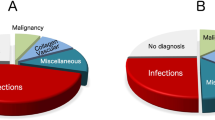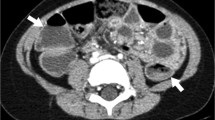Abstract
Autoinflammatory conditions (AIC) or hereditary recurrent fevers (HRF) include recently identified, very rare conditions usually presenting in childhood with a wide range of severities. This chapter summarizes current knowledge of AIC and their management during adolescence and young adulthood. Some AIC are well characterized, but new features and syndromes are being identified making this an evolving field. AIC require multidisciplinary care combining pediatric/adolescent/adult rheumatology, immunology, and infectious disease professionals, all with a focused special interest in the field and linked with national specialist services.
Access provided by Autonomous University of Puebla. Download chapter PDF
Similar content being viewed by others
Keywords
Introduction
The rarity of AIC can lead to delayed recognition throughout adolescence and into adulthood [1, 2]. Some resolve in childhood but more require long-term care into adult life.
The Eurofever project [2] has recruited patients from 28 countries with an age range of 0–67 allowing assessment of long-term outcomes and responses to modern treatment. However, the range of diseases and overlaps in presentation make it difficult to apply specific labels at times. Table 13.1 highlights the number of genetic variants for four well-characterized phenotypes of AIC (with more being identified all the time). The age range at diagnosis means that AYA with AIC are an important group to consider.
Presenting Features of AIC
Key features suggesting possible AIC are recurrent febrile episodes, sometimes with predictable timing, associated with stereotypical and repeated symptoms of multi-organ inflammation. These include skin rashes that can be urticarial or neutrophilic, periorbital or perioral swelling, inflammation of mucosal and serous membranes, or serositis. Myalgia and arthralgia with intermittent muscle, joint, and fascial inflammation may mimic other rheumatological conditions like dermatomyositis. Gastrointestinal symptoms including vomiting and mouth ulcers are common with hepatosplenomegaly with or without lymphadenopathy. The central nervous system, hearing, and eye features all vary in severity. Acute phase reactants are raised, and neutrophilia is common with episodes, such that infections are rightly considered and ruled out with significant flares.
Pathogenesis
Many AIC are caused by defined mutations affecting function of the innate immune system. Some are clear monogenic autoinflammatory disorders (see Table 13.2). Other disorders, now considered to be related to autoinflammatory conditions (e.g., systemic onset juvenile idiopathic arthritis, chronic multifocal osteomyelitis, Behcet’s disease, and the crystal arthritides), appear to be more polygenic. In these cases the autoinflammatory label is based more on interleukin 1 (IL1) overproduction or responses to anti-IL1 receptor blockade rather than genetics.
There is disordered control of the inflammasome and of apoptotic processes because of the genetic abnormalities [1] and cells have an abnormal way of sensing danger. The inflammasome is the part of the cell where caspase-1 and production of pro-inflammatory cytokines like IL1beta are activated and prepared for defending against infection. In AIC this response is apparently triggered spontaneously and is exaggerated with vast overproduction of pro-inflammatory cytokines (especially IL1). In contrast to autoimmune diseases, there is no autoantibody production and no antigen-specific T lymphocyte response.
This leads to recurrent episodes of infection-like, inflammatory symptoms with raised inflammatory cytokines but without a specific infective or disease-driven trigger. Flares can occur with stress including psychological stress, menstruation, physical exercise, immunizations, minor trauma, surgery, or viral infections but more usually without any specific trigger.
AICs have variable genetic penetrance and may only be diagnosed in adult life [4, 5]. As relatively recently described conditions, still considered to be incredibly rare, they may not appear in adolescent or adult differential diagnoses lists. Any late diagnosis really does matter, however, as treatment is needed as early as possible to avoid complications such as life-threatening systemic secondary amyloidosis , reported in up to 25% of patients.
Labelling the genetically negative cases is difficult in practice. It is important for teams to have access to a diagnostic chart of classical features to aid the acquisition of clinical skill from the experience of diagnosing these conditions. The NOMID Alliance (www.autoinflammatory.org) have helpful information for young people and professionals alike for this aspect of care.
Types of Autoinflammatory Conditions
A summary summarizing current knowledge AIC is given in Table 13.2.
AYA-Specific Features of AIC
These rare conditions are usually diagnosed in childhood in specialist services, but late diagnoses still occur in AYAs due to lack of awareness. The implications of a late diagnosis in young adult life are significant especially as, for example, NOMID/CINCA can cause developmental delay if untreated early in childhood [6, 7]. It is also potentially devastating to face the fact of a lifelong genetic disorder being diagnosed for the first time as an AYA. A crucial long-term outcome of AIC if untreated is amyloidosis , and therefore keeping AYA engaged with treatment for AIC is key (see Chap. 19). Specific AYA considerations for AIC are summarized in Table 13.2.
Principles of Treatment in AICs
Three treatment objectives are (i) controlling symptoms, (ii) improving quality of life, and (iii) preventing long-term complications. Colchicine is still the mainstay of treatment in FMF. But for most of the other conditions, IL1 blockade has proved to be effective where other treatments including treatment with steroids have failed to bring lasting control [4].
Transition and Practical Care Considerations
There are no specific publications prepared for transition in AIC, and principles for support of psychological well-being and coping strategies are therefore extrapolated from work on other genetic conditions that cause chronic health problems (see Chap. 21).
Treatment with very expensive biologic therapies such as canakinumab has led to national schemes, e.g., through the National Amyloidosis Centre in the UK. In this care pathway, there is the benefit of major expertise in rare conditions focused in one place but with the drawback of the need to travel for medical care.
There is always the need to balance short-term well-being with known long-term risks of untreated conditions in terms of potential neurological impairment in CAPS or the development of amyloidosis in later life. In young people the concept of long-term preventive treatment versus screening for amyloidosis with treatment at a later date also needs to be discussed. There is the possibility of episodic flare aborting treatment for acute flares versus long-term regular treatment to maintain symptom control. The counselling for each of these aspects of care is now to be assisted by data from disease registries and their potential to answer the questions of long-term or lifelong treatment.
Psychological Well-Being and Coping Strategies
Having a rare disease that no one knows much about during adolescence can prove a real challenge for the AYA especially during transition [8]. However, this is also an opportunity for them to become real experts in their own condition and to take self-advocacy to a new level as in reality they can easily know more about the condition than many of the HCPs that they will encounter. It is empowering to have clear links to good sources of up-to-date information that the AYA could refer the HCP to and again the NOMID Alliance (www.autoinflammatory.org) can prove invaluable.
Key Management Points
-
1.
Bouts of illness in TRAPS may last longer in older young people and adults.
-
2.
Amyloidosis risk may be higher in childhood-onset patients, longer disease duration, and higher penetrance, e.g., in R92Q-related disease [3].
-
3.
Canakinumab supply issues require centralized referral.
-
4.
Neurological involvement in CAPS is frequent, and most patients have difficulties with school performance and consequences for adult life chances [6].
-
5.
Care should be by combined inter-specialty teams that have a focused special interest in the conditions combining rheumatology and immunology.
-
6.
Long-term outcome studies are vital including scoring for the autoinflammatory disease activity and damage indices (ADDI).
References
Caso F, Rigante D, Vitale A, Lucherini OM, Costa L, Atteno M, Compagnone A, Caso P, Fredianai B, Galeazzi M, Punzi L, Cantarini L. Monogenic auto-inflammatory syndromes: state of the art on genetic, clinical and therapeutic issues. Int J Rheumatol. 2013;2013:513782. https://doi.org/10.1155/2013/513782. Epub 2013 Oct 24.
Papa R, Doglio M, Lachmann HJ, Ozen S, Frenkel J, Simon A, Neven B, Kuemmerle-Deschner J, Ozgodan H, Caorsi R, Federici S, Finetti M, Trachana M, Brunner J, Bezrodnik L, Gago MCP, Maggio MC, Tsitsami E, Al Suwairi W, Espada G, Shcherbina A, Aksu G, Ruperto N, Martini A, Ceccherini I. Marco Gattorno and for the Paediatric Rheumatology International Trials Organisation (PRINTO) and the Eurofever Project. A web-based collection of genotype- phenotype associations in hereditary recurrent fevers from the Eurofever registry. Orphanet J Rare Dis. 2017;12:167. https://doi.org/10.1186/s13023-017-0720-3.
Ruiz-Ortiz E, Iglesias E, Soriano A, Buján-Rivas S, Español-Rego M, Castellanos-Moreira R, Tomé A, Yagüe J, Antón J, Hernández-Rodríguez J. Disease phenotype and outcome depending on the age at disease onset in patients carrying the r92Q low-penetrance variant in TNFRSF1A gene. Front Immunol. 2017;8:299. https://doi.org/10.3389/fimmu.2017.00299.
Vitale A, Rigante D, Lucherini OM, De Palma A, Orlando I, Gentileschi S, Sota J, Simpatico A, Fabiani C, Galeazzi M, Frediani B, Cantarini L. The diagnostic evaluation of patients with a suspected hereditary periodic fever syndrome: experience from a referral center in Italy. Intern Emerg Med. 2017;12(5):605–11. https://doi.org/10.1007/s11739-017-1622-z. Epub 2017 Feb 13.
Hernández-Rodríguez J, Ruíz-Ortiz E, Tomé A, Espinosa G, González-Roca E, Mensa-Vilaró A, Prieto-González S, Espígol-Frigolé G, Mensa J, Cardellach F, Grau JM, Cid MC, Yagüe J, Aróstegui JI, Cervera R. Clinical and genetic characterization of the auto-inflammatory diseases diagnosed in an adult reference center. Autoimmun Rev. 2016;15(1):9–15. https://doi.org/10.1016/j.autrev.2015.08.008. Epub 2015 Aug 21.
Mamoudjy N, Maurey H, Marie I, Koné-Paut I, Deiva K. Neurological outcome of patients with cryopyrin-associated periodic syndrome(CAPS). Orphanet J Rare Dis. 2017;12:33. https://doi.org/10.1186/s13023-017-0589-1.
Kuemmerle-Deschner JB, Ozen S, Tyrrell PN, Kone-Paut I, Goldbach-Mansky R, Lachmann H, Blank N, Hoffman HM, Weissbarth-Riedel E, Hugle B, Kallinich T, Gattorno M, Gul A, Ter Haar N, Oswald M, Dedeoglu F, Cantarini L, Benseler SM. Diagnostic criteria for cryopyrin-associated periodic syndrome (CAPS). Ann Rheum Dis. 2017;76(6):942–7. https://doi.org/10.1136/annrheumdis-2016-209686. Epub 2016 Oct 4.
Foster HE, Minden K, Clemente D, Leon L, McDonagh JE, Kamphuis S, Berggren K, van Pelt P, Wouters C, Waite-Jones J, Tattersall R, Wyllie R, Stones SR, Martini A, Constantin T, Schalm S, Fidanci B, Erer B, Dermikaya E, Ozen S, Carmona L. EULAR/PReS standards and recommendations for the transitional care of young people with juvenile-onset rheumatic diseases. Ann Rheum Dis. 2017;76(4):639–46.
Author information
Authors and Affiliations
Corresponding author
Editor information
Editors and Affiliations
Rights and permissions
Copyright information
© 2019 Springer Nature Switzerland AG
About this chapter
Cite this chapter
Baildam, E. (2019). Autoinflammatory Conditions in Adolescence and Young Adulthood. In: McDonagh, J., Tattersall, R. (eds) Adolescent and Young Adult Rheumatology In Clinical Practice. In Clinical Practice. Springer, Cham. https://doi.org/10.1007/978-3-319-95519-3_13
Download citation
DOI: https://doi.org/10.1007/978-3-319-95519-3_13
Published:
Publisher Name: Springer, Cham
Print ISBN: 978-3-319-95518-6
Online ISBN: 978-3-319-95519-3
eBook Packages: MedicineMedicine (R0)




